Pentium 4 3.46 Extreme Edition and 925XE: 1066MHz FSB Support is Here
by Anand Lal Shimpi on October 31, 2004 3:00 PM EST- Posted in
- CPUs
Workstation Applications
Visual Studio 6
Carried over from our previous CPU reviews, we continue to use Visual Studio 6 for a quick compile test. We are still using the Quake 3 source code as our test and measure compile time in seconds. The results are pretty much in line with what we've seen in the past.
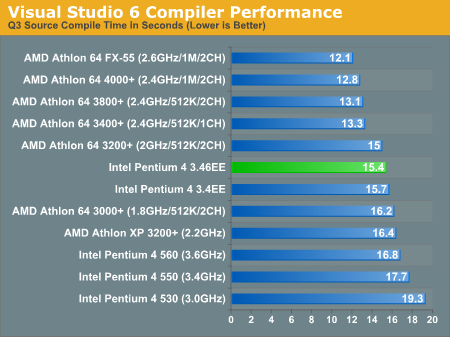
SPECviewperf 8
For our next set of professional application benchmarks we turn to SPECviewperf 8. SPECviewperf is a collection of application traces taken from some of the most popular professional applications, and compiled together in a single set of benchmarks used to estimate performance in the various applications the benchmark is used to model. With version 8, SPEC has significantly improved the quality of the benchmark, making it even more of a real world indicator of performance.
We have included SPEC's official description of each one of the 8 tests in the suite.
3dsmax Viewset (3dsmax-03)
"The 3dsmax-03 viewset was created from traces of the graphics workload generated by 3ds max 3.1. To insure a common comparison point, the OpenGL plug-in driver from Discreet was used during tracing.
The models for this viewset came from the SPECapc 3ds max 3.1 benchmark. Each model was measured with two different lighting models to reflect a range of potential 3ds max users. The high-complexity model uses five to seven positional lights as defined by the SPECapc benchmark and reflects how a high-end user would work with 3ds max. The medium-complexity lighting models uses two positional lights, a more common lighting environment.
The viewset is based on a trace of the running application and includes all the state changes found during normal 3ds max operation. Immediate-mode OpenGL calls are used to transfer data to the graphics subsystem."
The biggest surprise here is that there is a huge performance impact (13%) by moving down to a single channel memory subsystem with the Athlon 64. There are also a couple of other surprises, with the Pentium 4 560 doing surprisingly well, coming in at the heels of the Athlon 64 FX-55.
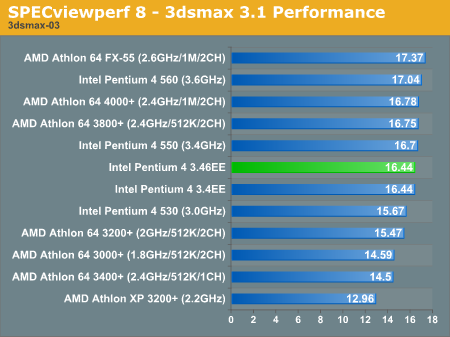
CATIA Viewset (catia-01)
"The catia-01 viewset was created from traces of the graphics workload generated by the CATIATM V5R12 application from Dassault Systems.
Three models are measured using various modes in CATIA. Phil Harris of LionHeart Solutions, developer of CATBench2003, supplied SPEC/GPC with the models used to measure the CATIA application. The models are courtesy of CATBench2003 and CATIA Community.The car model contains more than two million points. SPECviewperf replicates the geometry represented by the smaller engine block and submarine models to increase complexity and decrease frame rates. After replication, these models contain 1.2 million vertices (engine block) and 1.8 million vertices (submarine).
State changes as made by the application are included throughout the rendering of the model, including matrix, material, light and line-stipple changes. All state changes are derived from a trace of the running application. The state changes put considerably more stress on graphics subsystems than the simple geometry dumps found in older SPECviewperf viewsets.
Mirroring the application, draw arrays are used for some tests and immediate mode used for others."

Lightscape Viewset (light-07)
"The light-07 viewset was created from traces of the graphics workload generated by the Lightscape Visualization System from Discreet Logic. Lightscape combines proprietary radiosity algorithms with a physically based lighting interface.
The most significant feature of Lightscape is its ability to accurately simulate global illumination effects by precalculating the diffuse energy distribution in an environment and storing the lighting distribution as part of the 3D model. The resulting lighting "mesh" can then be rapidly displayed."

Maya Viewset (maya-01)
"The maya-01 viewset was created from traces of the graphics workload generated by the Maya V5 application from Alias.
The models used in the tests were contributed by artists at NVIDIA. Various modes in the Maya application are measured.
State changes as made by the application are included throughout the rendering of the model, including matrix, material, light and line-stipple changes. All state changes are derived from a trace of the running application. The state changes put considerably more stress on graphics subsystems than the simple geometry dumps found in older viewsets.
As in the Maya V5 application, array element is used to transfer data through the OpenGL API."
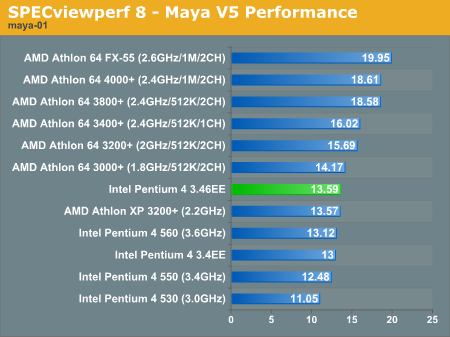
Pro/ENGINEER (proe-03)
"The proe-03 viewset was created from traces of the graphics workload generated by the Pro/ENGINEER 2001TM application from PTC.
Two models and three rendering modes are measured during the test. PTC contributed the models to SPEC for use in measurement of the Pro/ENGINEER application. The first of the models, the PTC World Car, represents a large-model workload composed of 3.9 to 5.9 million vertices. This model is measured in shaded, hidden-line removal, and wireframe modes. The wireframe workloads are measured both in normal and antialiased mode. The second model is a copier. It is a medium-sized model made up of 485,000 to 1.6 million vertices. Shaded and hidden-line-removal modes were measured for this model.
This viewset includes state changes as made by the application throughout the rendering of the model, including matrix, material, light and line-stipple changes. The PTC World Car shaded frames include more than 100MB of state and vertex information per frame. All state changes are derived from a trace of the running application. The state changes put considerably more stress on graphics subsystems than the simple geometry dumps found in older viewsets.
Mirroring the application, draw arrays are used for the shaded tests and immediate mode is used for the wireframe. The gradient background used by the Pro/E application is also included to better model the application workload."
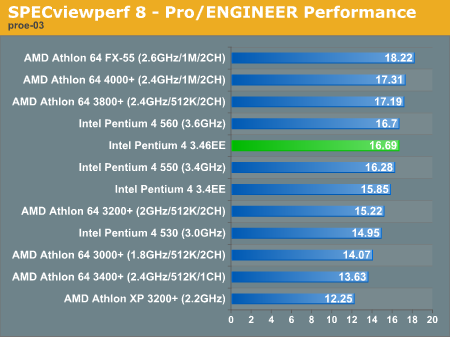
SolidWorks Viewset (sw-01)
"The sw-01 viewset was created from traces of the graphics workload generated by the Solidworks 2004 application from Dassault Systemes.
The model and workloads used were contributed by Solidworks as part of the SPECapc for SolidWorks 2004 benchmark.
State changes as made by the application are included throughout the rendering of the model, including matrix, material, light and line-stipple changes. All state changes are derived from a trace of the running application. The state changes put considerably more stress on graphics subsystems than the simple geometry dumps found in older viewsets.
Mirroring the application, draw arrays are used for some tests and immediate mode used for others."
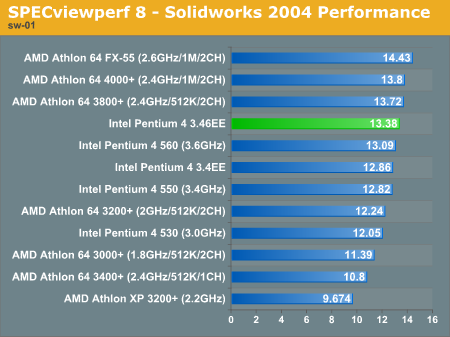
Unigraphics (ugs-04)
"The ugs-04 viewset was created from traces of the graphics workload generated by Unigraphics V17.
The engine model used was taken from the SPECapc for Unigraphics V17 application benchmark. Three rendering modes are measured -- shaded, shaded with transparency, and wireframe. The wireframe workloads are measured both in normal and anti-alised mode. All tests are repeated twice, rotating once in the center of the screen and then moving about the frame to measure clipping performance.
The viewset is based on a trace of the running application and includes all the state changes found during normal Unigraphics operation. As with the application, OpenGL display lists are used to transfer data to the graphics subsystem. Thousands of display lists of varying sizes go into generating each frame of the model.
To increase model size and complexity, SPECviewperf 8.0 replicates the model two times more than the previous ugs-03 test."











63 Comments
View All Comments
IntelUser2000 - Monday, November 1, 2004 - link
Intel is not doing bad. They are doing terrible. So terrible that you might as well call them dead. Probably will last till 2009 before they fill bankruptcy.To those people who say people in forums don't know anything and that there are other people stupid enough to buy Intel chips(I mean all Intel chips): Uhh, yeah, get your head straight, since AMD is closing with Intel very rapidly in marketshare, in server, desktop, and laptop, and that means that gamers actually do make a difference(albeit slowly) making other people buy computers. You think other people will buy P4's because of high clock speed? That's BS, since people who is stupid enough to buy Intel chips don't even know what clock speeds does. There are only a very few that knows computers JUST enough to say clock speed is good.
Tides - Monday, November 1, 2004 - link
believe me, everyone wants the best they can get for the least cash.FinalFantasy - Monday, November 1, 2004 - link
Intel is not doing good right now. I know a lot of people rested their hopes for Intel to strike back with the release of this chip. But alas, we are still seeing the same problems with this chip as we've seen with it's predecessors.1. Way overpriced
2. Still getting whooped by AMD's 64-bit chips
The choice is clear here, buy an average AMD chip for a fraction of the price and still be able to outperform your friend's Intel EE based machine that he spent $2,500-3,000 on to build, while you spent about $1,500 (factor in price a person pays for an Intel EE chip and a couple of sticks of DDR2).
Pandaren - Monday, November 1, 2004 - link
What the community here forgets is that the common person doesn't care for 10 extra FPS in a game or 3 seconds faster on that photoshop filter. They want a reliable, dependable computer with good support at a reasonable price.Dell provides that with Intel chips. People honestly don't care if the Intel chip is not faster.
Those of us who do care about performance and price/performance will build our own. I replaced my Dell with a homebuilt AMD box for that reason, but I don't expect everyone to do the same.
SLIM - Monday, November 1, 2004 - link
"SLIMYou're forgetting DDR2 price which this needs in your so called Intel is "cheaper" comparison. If you want the same price setup you can get a FX-55 and really bring the wood."
ZEBO
Perhaps you didn't read my post correctly or didn't read the review, but the first paragraph in post #14 is a direct quote from the review (that's why there are QUOTATION MARKS around it). The two comments below the QUOTE were my views on Anand's conclusion of the 560 v 3800 comparison at the end of the review. Your comment actually agrees with what I said.
Tides - Monday, November 1, 2004 - link
they would if they had itswatX - Monday, November 1, 2004 - link
why doesnt intel just release a dual core platform or a 64bit chip already..gezz its like they are acting like ATI "we will release 64-vit chips only when apps start to use it" ...NotMrT - Monday, November 1, 2004 - link
Last time i remember AMD domminating this much was in the time of the thunderbirdsChapbass - Monday, November 1, 2004 - link
#43:One thing that i can vouch for, being a college student: Almost every college student not "in the know" with building systems buys a dell....because theyre sold through the college. At least my college they are. DEFINITELY the most common systems around here (and it makes me sick) : P.
It seems like households are more into HP/compaq, where schools, both k-12 and college, are totally dell.
Just something ive noticed around where im from. YMMV.
-Chap
justly - Sunday, October 31, 2004 - link
I find it interesting that the page compareing an A64 3800+ to the P4 560 shows the P4 winning the multitasking content creation. Well that isn't the interesting part, but the fact that Intel only won this because it took all three SYSmark tests is (the SYSmark tests wher the only thing Intel won in this catagory). I guess what really amuses me is remembering a comment in a article a while back (I think it was Anand himself who made the comment) implying that the SYSmark scores did not reflect the rest of their testing and that it seemed to favor Intel.